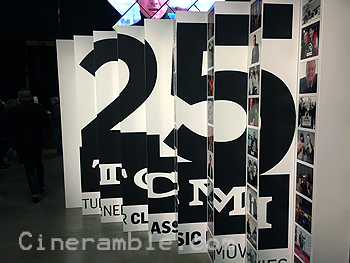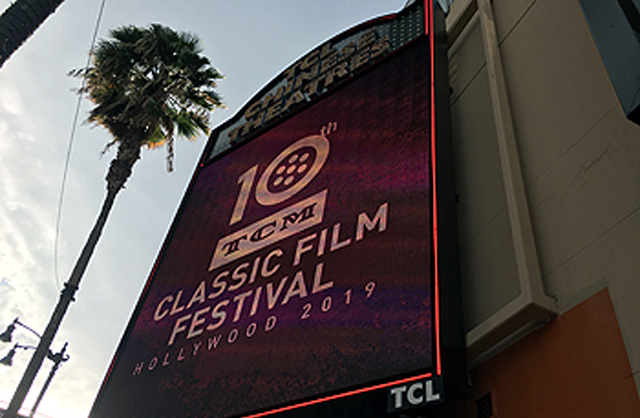
Every mid to late Spring here in sunny Los Angeles the film industry usually takes a breather before it kicks into high gear for the Summer, but I have managed to find a special yearly event that hits the right sweet spot for cinephiles from all over here in town. Turner Classic Movies has put on this annual Film Festival right in the heart of Hollywood, and I have been fortunate enough to not only be able to watch one movie there, but several, even in a single weekend. It’s a great event for both industry insiders and casual fans alike to gather together and see all our favorite classic films in the way they were intended to be seen, on the big screen. Every year, I watch a collection of movies that I’ve seen before but never on a big screen, and sometimes I manage to catch a movie that is completely new to me in the hopes of finding that new discovery. In addition, TCM goes out of their way to bring the actual people involved with the making of these movies to appear and introduce the film we are about to see, making the experience all the more magical and worth the price of admission. This is, however, a special year as the TCM Film Festival celebrates it’s 10th anniversary. Playing within the same venues throughout it’s decade of operation (the theaters along historic Hollywood Boulevard), the TCM has grown steadily in popularity every year, and has also managed to get even better over time. I’ve been fortunate to have caught the last 7 festivals, with this year being my 8th. And each year, I’ve been topping my total number of films attended. Even with the unexpected schedule conflict of Avengers: Infinity War keeping me from going on the first day, I still topped my record by seeing 9 films last year. It’s quite the bump since my first year, when I only saw the one. Thankfully, Avengers: Endgame is still two weeks off, so I have a pretty good chance of hitting the double digits for the first time this year.
This year, to keep my thoughts and reactions fresh for all of you reading, I will be covering this year’s festival again live as I’m attending. With updates on each previous day’s experiences throughout the weekend, my hope is to give you an accurate first hand experience of this festival, hopefully encouraging those reading this live in the Los Angeles area to at least give it a look while it’s still going on. I’ll be sharing all the sights and sounds of my festival experience, telling you what I saw, who I saw, and just anything interesting that I end up seeing throughout the festival. I’ll even try my best to include pictures along the way, depending on how well my phone’s camera processes them. One of the most interesting new things about this year’s festival is the addition of a new venue. This year, films will be screened for the first time at the nearby landmark Hollywood American Legion Post 43 facility. This art deco styled structure has served the Hollywood Veteran community for many years, and it’s great to see them open their doors to festival goers to watch movies in their well furnished auditorium. Hopefully, if things turn out well, I’ll be able to include a screening here as part of this year’s festival. It’s neat to see yet another historic landmark celebrated alongside the Egyptian, the Chinese, the Cinerama Dome, and all these other monuments to cinema, which is another thing that sets this festival apart. So, with intros out of the way, let’s enjoy this 10th TCM Classic Film Festival.

APRIL 11TH, 2019 (DAY 1)
The afternoon launch of the festival thankfully coincided well with my work schedule, so I arrived just as things were getting started. As they’ve done the past few years, the Festival is launched with a special red carpet screening in the primary venue of the TCL Chinese Theater. This one is limited only to special guests and the highest level pass-holders. Because of that exclusivity, every red carpet screening have to be a special one. Last year marked an even more special event for guests, because it marked the first presentation of the Robert Osborne Award. This newly christened honor is going to be given out each year to a recipient whose work toward preserving and promoting classic movies deserves special distinction. Named after the late TCM host, the first year’s honorees was director Martin Scorsese, who was introduced by actor Leonardo DiCaprio. Of course, this is the special kind of exclusive event deserving of the red carpet treatment, and I’m sure that anyone who attends these certainly gets their money’s worth. I haven’t quite reached that level yet, but there’s still plenty left to see at this Festival.

This year, the red carpet was rolled out for the 30th Anniversary screening of the classic romantic comedy, When Harry Met Sally. In attendance for this special screening was not only the director, Rob Reiner, but also the film’s stars Billy Crystal and Meg Ryan. From what I’ve read, this is the first time all three have appeared together since the film’s release, so for any long time fan of the film, this had to be a real once in a lifetime experience if they managed to get in to this screening. When, I arrived, the red carpet was still rolled out, and attendees were still walking up to The Chinese. As close as I could get was to the outer wings, where many other bystanders were looking over the barriers to see who was there. I was amazed to see how many people had dressed up for this. This is very likely the only screening at this Festival where this level of class was necessary. Inside, before the screening, the special guests sat down for an interview with TCM’s Ben Mankiewicz, whose schedule for the next few days is likely going to be full of these introductions. In addition to participating in this opening night show, the Festival also has a hand-print ceremony the following morning in front of the Chinese, where one of the night’s special guests gets to add their own mark to the other prints left in the famous theater’s front court. In this case, it’s Billy Crystal who has the honor. But, this is another event that I unfortunately cannot attend, so let’s begin talking about what I did see.
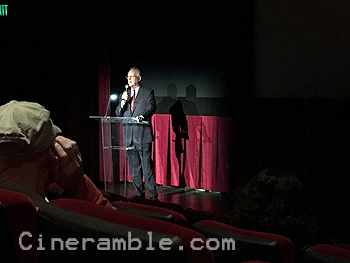
Running almost at the same time as When Harry Met Sally there were other screenings in the Chinese Multiplex next door. These smaller theaters have their own set of classic movies for the Festival, and usually they are of the hard to find kind. For instance, the first movie I ended up watching was a movie called Dark Passage (1947) which was a Bogart and Bacall movie that I’d never even heard of before. After their breakthrough films like To Have and Have Not (1944) and The Big Sleep (1946), Warner Brothers sought to capitalize on this dynamic film partnership that turned into a real life romance, and this film was one of those results. The movie was introduced by Eddie Muller, who is the host and curator of TCM’s bloc of film noir centered programming called appropriately enough, “Noir Alley”. Muller is ideally suited to introduce a film like Dark Passage because it is quintessential noir. He told us a lot of interesting behind the scenes tidbits, such as the fight that producer Jerry Wald has with Jack Warner over the plan to hide Humphrey Bogart’s face for a third of the movie. It’s an unusual storytelling device, especially given Bogart’s star power, but it makes sense in the context of the film. Muller also talked about the author, the music and all the other things that made this movie stand out in it’s time. As noir films go, it’s a really unusual one, and that’s saying something. This is the kind of movie I especially love to find at these festivals, because they are what you’d call the discoveries. So, with one movie down, it was off to the next.

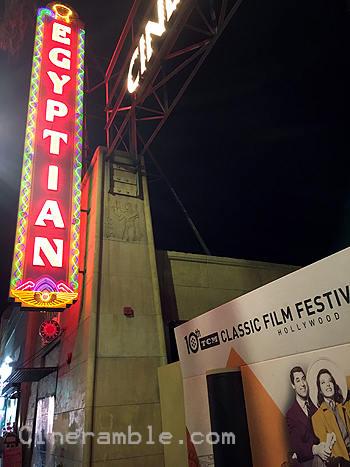
Since I missed out on one of the special nitrate screenings last year at the Egyptian Theater, I figured it was best to not waste any time this year. With a short two block walk down Hollywood Boulevard, I made it to my next show with plenty time to spare. The Egyptian, operated by American Cinemateque and soon to be under the ownership of Netflix, specializes in screenings of all film formats, and especially with the very rare screenings of the extremely volatile nitrate film stock. For this particular showing, we were being treated to a presentation of the classic Cary Grant screwball comedy The Bachelor and the Bobby-Soxer (1948), co-starring Myrna Loy and a teenage Shirley Temple. This was yet another movie I had yet to see, so watching it both on the big screen and with a rare nitrate print was especially fortunate. Even more remarkable, as we the audience learned from the brief introduction, this print not only came from the Academy archive, it was also donated to them by Shirley Temple herself. The movie is lighthearted fluff, but it’s a great showcase for both Cary Grant and Shirley Temple’s incredible on screen charisma. With that, my first night comes to a close, and after working my morning shift in my day job, I’ll be back and ready for day 2.
APRIL 12, 2019 (Day 2)
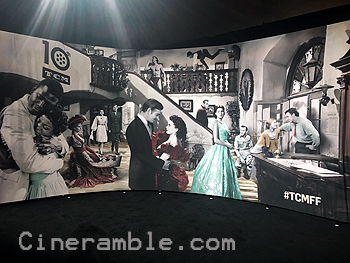
While cutting it close coming here directly from work, I still managed to get into my first movie of the night. Making my way to the Chinese Multiplex in the Hollywood and Highland Center I got in line for the early evening screening of Francois Truffaut’s Day for Night (1973). The French New Wave classic is Truffaut’s ode to the process of film-making, pulling back the curtain to show the behind the scenes dramas that take place around a film set. For this screening, the film was proceeded by a special pre-show interview with the film’s star Jacqueline Bisset. Talking with Noir Alley’s Eddie Muller once again, the interview was a nostalgic journey through Ms. Bisset’s long career, and in particular, her experiences working on Day for Night. She described what it was like working with Truffaut, with the cast members, and how making films in France was so different from how they are made in Hollywood. One of her most amusing anecdotes was about the confusion they had on set because of the way it was a movie about making a movie. Because Truffaut played the part of the director himself, the cast sometimes were confused about whether he had called “cut” for real, not knowing if the scene was in fact finished. Jacqueline was very gracious in her recollections, and it was a treat to hear her stories before the movie began, especially with the context that her own behind the stories offered. And after this, it was time to head over to the Chinese for the night’s premiere screening.

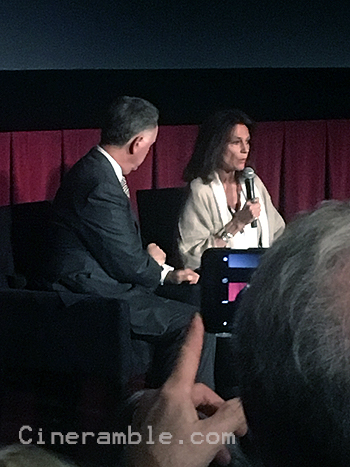
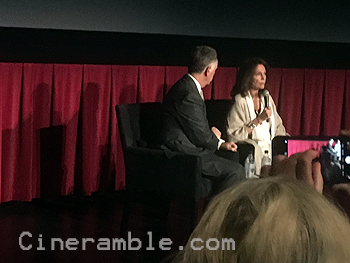
Over in the Chinese, this second night was reserved for a special 30th Anniversary screening of Spike Lee’s now legendary Do the Right Thing. Introduced by TCM’s Ben Mankiewicz, it was especially pointed out that this movie was a product of it’s time, but also just as timely today as it was then. Ben’s introduction was followed up with an interview with three ladies who were very important to the making of the movie. One was casting director Robi Reed, costume designer (and recent Oscar winner for Black Panther) Ruth E. Carter, and actress Joie Lee who played the part of Jade in the film, and who is also Spike Lee’s real life sister. All three had many wonderful insights about their experiences working on this film, as well as taking a moment to reflect on the movie’s important impact in both cinema and society. Joie had the most interesting reflections about what it was like working with her brother, who she acknowledged could be a handful at some points, but always respectful of those who worked on his films. Ruth discussed the very crucial aspects of the film’s making, including the steps they took to make the feel of a scorching hot day come through in the wardrobes of all the characters. And Robi Reed discussed how the amazing ensemble cast was formed, which included legendary performers like Ossie Davis and Ruby Dee, some of Lee’s favorite frequent cast members like Samuel L. Jackson and John Tuturro, as well as fresh newcomers whose careers were going to take off in the years ahead like Rosie Perez and Giancarlo Esposito. The interview concluded with their thoughts about the recent Oscar win for Green Book, which none of the ladies were particularly happy about, especially given the fact that Spike Lee’s own film BlackkKlansman lost out to it. Given that I share their same frustrations, this made me very happy to hear from them, because it needed to be said. The movie was given a new 4K restoration in anticipation of a just announce Criterion release, and the film looks incredible, especially with the colors which really pop off the screen. This concluded my second, short day of the festival, but starting tomorrow, it’s nothing but movies morning to night, with hopefully my first glimpse of the American Legion Post.
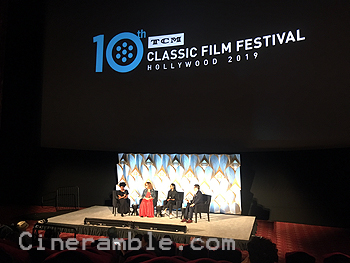

APRIL 13, 2019 (DAY 3)
If everything went off without a hitch, this would be a day where I could see as much as 5 films in a single day. To start off this marathon, I arrived extra early to the Chinese Multiplex to see the the first film of the day. This movie would end up being the 50’s technicolor Sci-Fi epic When Worlds Collide (1951), produced by special effects extraordinaire George Pal. It fit with my goal this year to watch more newer movies than I have before, plus it was also short, which allowed me more downtime to breath between films. The extra treat of this show was that it also included a brief interview with one of the film’s stars; the graceful Barbara Rush. For someone who’s just turned 92 years old, she looked absolutely fabulous and is still in wonderful shape and spirits for her age. She was interviewed by comedian and guest TCM programmer Dennis Miller, who you can tell is a fan of these classic Sci-Fi films from that era. Both Miller and Rush had a fun, spirited discussion about the film, with Barbara remembering what it was like to work with her co-stars, as well as the many other projects she worked on before and since making this particular film, talking fondly about how her work has withstood the test of time pretty well. She even talked about getting to work with giants like Marlon Brando and Paul Newman in other films later on. After the interview, we were presented with a beautifully restored digital presentation of the film, which really brings the colorful cinematography to full brightness. The film is what you’d expect, a cheesy relic of it’s time, but the audience was certainly appreciating it. After that early morning start, it was off to one of my most anticipated moments of this festival; my first movie in the brand new venue.

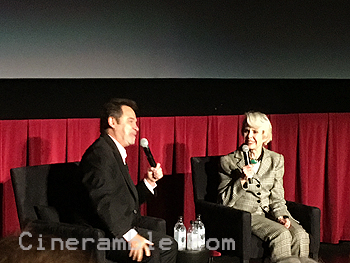
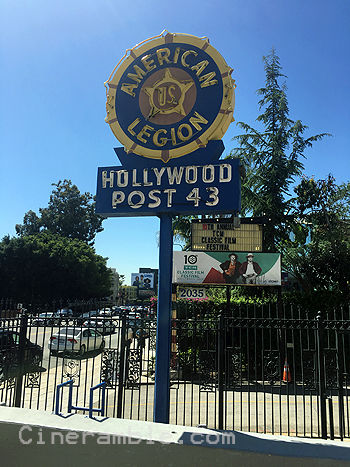
In a two block walk up hill along the always busy Highland Avenue, the newest theater added to the festival’s venues is found. The Hollywood Legion Post 43 is a stunning, but often overlooked landmark in this neighborhood of iconic structures. The outside is this beautiful art deco facade, with plagues dedicated to all the servicemen who have been in charge of operating it over the years. Standing since 1929, the Post has served war vets of the Hollywood community for decades, and it’s members have included the likes of Clark Gable, Charlton Heston, and even Stan Lee. Though the outside of the Post is impressive enough, it’s the inside that really inspires admiration. After walking through the subtle but lofty atrium, two wooden doors open up to the structure’s most impressive feature, the auditorium. Though not as lavishly ornate as the Chinese, the Legion Post’s expansive auditorium has this wonderful cathedral like elegance to it, with arched buttresses descending from the ceiling. You honestly would never have expected this auditorium to have been this big based on the front facade. I can see now why TCM wanted to add this to their list of venues, and I’m very glad that the Legion decided to open it’s doors to festival goers. For a first time visitor like me, see this place in all it’s glory was definitely one of the highlights of this year’s festival. The venue has always had a projection room, but has not screened films on a regular basis. I’ve heard that this is about to change as the Legion is planning to have more film events in the future.
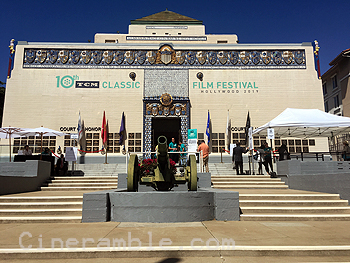
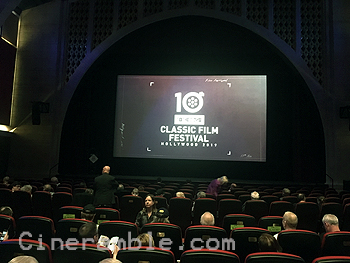
Interesting enough, my first experience in the Legion Post was not for a film, but rather a multimedia presentation, which is also part of the usual programming at each festival. This one in particular was called Fox: An Appreciation. Of course, the subject was the 20th Century Fox studio and it’s history, which was interesting to watch, notably after the finalization of Fox’s merger with Disney last month. The presentation was put together and hosted by Fox archivist Schawn Belston, who not only gave us a very fascinating and broad in scope overview of the history of Fox, but he also told us a great deal about the incredible hard work it has taken to preserve all of these cinematic treasures over the years. Between each point of his presentation, he would present a clip from each of the respective films in his discussion, and by showing all of them, you really get a great sense of the overall impact that Fox left on Hollywood throughout the whole history of cinema. You sometimes forget how many great and important movies have come out of one studio, and from all different eras as well. In the course of the 90 minute presentation, we saw the likes of Sunrise (1927), How Green Was My Valley (1941), All About Eve (1950), Cleopatra (1963), Planet of the Apes (1968), M*A*S*H (1971), Big (1988), Die Hard (1988) and Titanic (1997). He also made special mention of the stars that put Fox on the map, like Henry Fonda, Marilyn Monroe and, of course, Shirley Temple. It was a great presentation that really renews your appreciation for this once mighty studio. It also made my first time at this new venue a pleasant one.
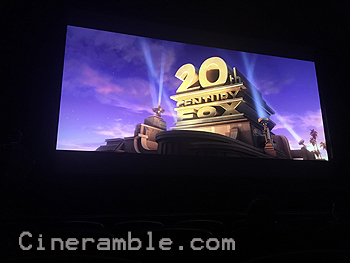
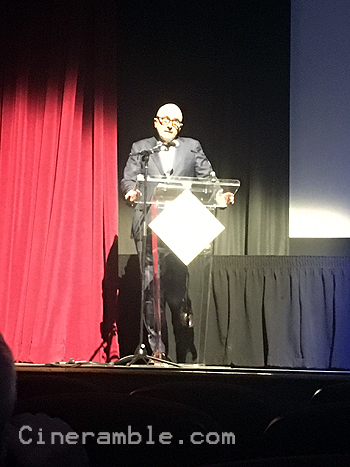
Heading back to Hollywood Boulevard, and after getting in a quick lunch, I arrived for my next movie at the Chinese Theater. It was a screening of Mike Nichols’ 1988 film Working Girl, starring Melanie Griffith and Harrison Ford. The special guest for this screening is also spotlighted as one of the main honorees of this entire festival; veteran casting director Juliet Taylor. A giant within the industry, Ms. Taylor has cast numerous films that have gone on to become classics, including numerous Woody Allen flicks, The Exorcist (1973), Taxi Driver (1976), Terms of Endearment (1983) and Schindler’s List (1993). For the screening of Working Girl, she was interviewed by actress Ileana Douglas, who asked her about the assembly of the film’s all-star cast. She talked quite a bit about how she had to make the tough decision to change the casting of the male lead in order to meet the studio’s demands. Originally, Alec Baldwin was cast opposite Melanie Griffith, but the studio wanted someone more established so they got Harrison Ford. Baldwin graciously bowed out and took the smaller role of Griffith’s ex boyfriend, and she Taylor was told that her handling of the situation helped to make the transition smooth. She also talked about how the movie helped launched both Griffith and Baldwin (who were still fairly green) into stardom, and helped establish Harrison Ford in a romantic comedy role, which he was not very well known for. It made for a fascinating interview and it’s nice to see someone of Ms. Taylor’s significance getting the recognition that she has at this festival.
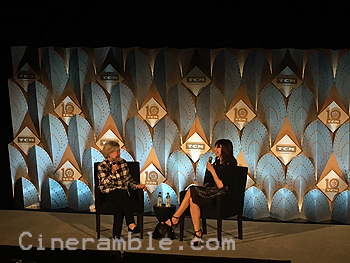

After that, I made my way back up to the Legion Post where my next film was. It was a screening of the classic William Wyler adaptation of Wuthering Heights (1939) starring Laurence Olivier and Merle Oberon. I’ve actually never seen this movie before in it’s entirety, so this was a perfect opportunity to do so. Also, what also drew me to see this movie on this day was the fact that it was being presented by long time Jeopardy host, Alex Trebek. Trebek recently announced that he is currently in treatment for very advanced cancer, so the fact that he’s made the time to attend this festival and participate in it as well is a really courageous thing to do on his part. From what I saw, he seemed to be doing alright at this time, not showing any signs of his illness outwardly. His introduction to the film was an excellent one, discussing his own personal connection to the film such as his first time watching it at a Drive-in theater in his native Canada, to visiting the English countryside that inspired the original book and the home of it’s author, Emily Bronte, with his wife many years back. It remains one of his favorite movies, and you could tell that talking about this movie meant a lot to him. As he finished and left the stage, the audience gave him a spirited ovation, showing that they both appreciated his presence at this Festival, and that they are all wishing him the best of luck in the days ahead.

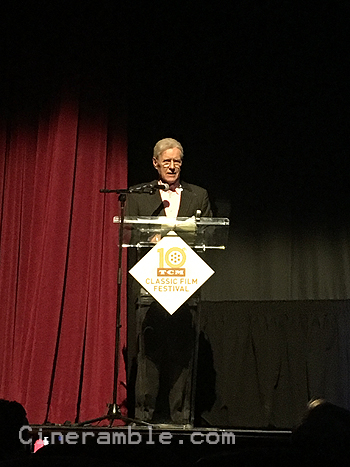
With four down, I had one more shot to make it a 5 for 5 day. The only question was what was it going to be. The choice was tough, because this night had two solid options; a screening of the original Star Wars (1977) in the Chinese Theater or a screening of Escape From New York (1981) in the multiplex, with director John Carpenter and star Kurt Russell in attendance. I initially decided on Escape from New York, because it’s yet another movie I haven’t fully seen plus, it had the bonus of the two main people responsible for it there, including the reclusive Carpenter. Unfortunately, the film sold out very early; even pass-holders were turned away, because the demand was so high. So, I tried my back-up option of Star Wars, which was thankfully still seating. Though I came halfway through the opening discussion, I was still able to get a glimpse of the special guests at the screening. In attendance were sound designer Ben Burtt, Visual Effects Artist Dennis Muren, and Special Photographic Cinematographer Richard Edlund. They of course were talking about the ground-breaking visual effects used in the movie, and how much they have gone on to shape the way movies are made today. Right before the end of the discussion, Ben Mankiewicz asked each one to list how many Oscars each of them have won, and the tally goes Burtt: 4, Murren: 8, and Edlund: 4. That’s an incredible 16 Oscars between all of them, and Star Wars is what initially propelled their rise in the industry. Though I have seen Star Wars many times before, I’ve never seen it projected on a big screen. And let me tell you, it’s an incredible experience. Also, seeing it in the same theater that it had it’s premiere over 40 years ago gave me a real sense of what that first night must have been like. Though it was my back-up, I have to say this was one of the highlights of my festival so far, and with one day left, it was a great way to finish my most robust day ever at the TCM Film Fest.

APRIL 14, 2019 (DAY 4)

Three days into the festival, and I’ve already tied my best number to date, so everything today is icing on the cake. I got up again for an early start (with only about 5 hours of sleep after Star Wars ran past midnight) and made my way to the Chinese for film number one. This was a 50th anniversary screening of the lavish Gene Kelley directed musical Hello, Dolly (1969). The film was a financial disaster when it was first released, mainly because of cost overruns and the fact that it came out too late to capitalize on the brief rise of widescreen epic musicals of the 1960’s. In the years since, it has found a following and has turned a modest profit for it’s studio, 20th Century Fox. One of those who’s deeply devoted to the movie is super fan Christopher Radko (the guy behind the Christmas Ornaments), who was the special guest at this screening. He talked about how much the movie has left a big impression on him, to the point where he now lives in the town of Garrison, NY, where much of the on location shooting was done. He also talked about the special anniversary festival in Garrison to mark the start of the film’s production in their town that he got to plan himself. Like Star Wars the night before, this is another movie that benefits from showing on the biggest screen possible. Though the movie does have many flaws, it’s lavishness is impressive to look on on a screen that can contain it’s full majesty. It makes you long again for a time when movie musicals had this much ambition behind them, but then again it’s that same ambition that made these kinds of movies too expensive to produce after a while.

After Hello, Dolly, I got right back in line for the next showing in the Chinese theater. This next film is one that I’m perhaps the most ashamed to confess that I haven’t watch the whole way through before. That film is the now universally beloved The Shawshank Redemption (1994). This Oscar nominated film has eluded me, purely because I was looking for an opportunity like this one to finally watch; namely seeing it on a movie theater screen. Shawshank has garnered this nearly unfathomable reputation as this absolute masterpiece, and I was worried that if I watched it the wrong way that it wasn’t going to live up to the hype. So, thankfully, I now had the opportunity to see it for the first time all the way through in the right manner, and in the Chinese Theater no less. To make the experience even better, director Frank Darabont was there to introduce the film beforehand. Interviewed by Ben Mankiewicz, Darabont revealed many interesting details about the making of this movie, like how he turned down a huge sum of money for the script so that he’d be able to direct it himself, and also how the producer came up with the novel idea of casting Morgan Freeman in the part of Red, even though he was originally written as a Irish-American white guy. He also talked about the challenges he had in adapting the original Stephen King novella, and how he was hesitant to include the film’s very upbeat ending at first. It was very cool to hear the director’s own take before seeing the movie itself. Though it’s not going to be anywhere near my all time favorite movies, I can definitely say that this is a movie deserving of it’s lofty reputation and I’m happy to have finally checked this one off my list.


Taking a longer lunch than usual, I was looking to close out my festival experience with just one more film. I made my way over to Egyptian for their next showing, which was going to be a special type of program that occasionally is presented at the TCM Fest. They were going to screen the Greta Garbo silent classic A Woman of Affairs, only instead of a pre-recorded soundtrack, it was going to be accompanied with a live, small orchestra. The introduction was going to be made by critic Leonard Maltin and this year’s Osborne Award recipient, film Preservationist and Filmmaker Kevin Brownlow. The orchestra would then perform under the direction of Conductor Carl Davis, who himself has composed new scores and orchestrations for many classic silent movies. Unfortunately, this special presentation was in high demand, and it ended up selling out before the standby line where I was queued up in could be let inside. So, I was left with two options, leave the festival early disappointed that I couldn’t get into my last show, or try to rush to another venue quick to watch one of the other film starting at the same time. Strangely, I not only chose the latter, but I chose to rush over to the venue furthest away from the Egyptian; that being the Legion Post. Even though I ran as fast as I could go, the movie had already started, and I missed out on the introduction done with comedian Mario Cantone and Jennifer Grant, daughter of Cary Grant. Here, they introduced one of Cary Grant’s popular early screwball comedies, My Favorite Wife (1940). Since I started my festival with another Cary Grant comedy, I guess it was fitting to end it with one too, and in the venue that was my favorite discovery of this entire festival. An added plus, the movie was shown on 35mm film, which I know for sure because the projector has a malfunction during the showing. As a past projectionist myself, I found this amusing since it’s the first time I’ve ever seen this happen at the festival, helping to reinforce the authenticity that we are given a true cinematic experience. And thankfully, the malfunction was nothing serious. So, after that, it was time to head home. I could have fit in one more movie if I wanted to, but having already brought my number up to 12, I felt it was time to head home finally, feeling very satisfied.


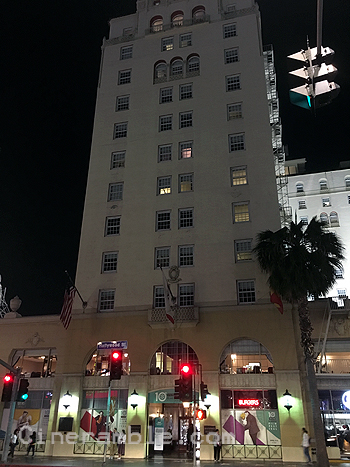
With the long weekend finally behind me, I now have a full year to be ready for the next festival. This was an extra special festival, because of the milestones it was hitting. TCM as a broadcast channel is marking it’s 25th year of existence, with it’s founder Ted Turner being celebrated throughout the fest, especially for his long history of seeking to preserve and promote classic films. And, of course this was the 10th year of the festival itself, which some of the TCM personal proclaimed excitement for in each of their presentations. Some thought it might not last past the first year, so the fact that it’s still going ten years strong is something quite miraculous to many of them. For me, I feel fortunate to have been living in Los Angeles long enough to have attended 8 out of the 10 festivals. Though I started off slow, with maybe one movie a year the first couple times, I have continually become more and more determined to experience the full extent of the festival, and this year I managed to hit my best number yet. I watch a whopping 12 movies in 4 days, and if I didn’t have to work Friday morning, I probably could have seen more. What is especially great about these festivals is meeting complete strangers in line or sitting next to you in the theater and striking up a conversation out of a mutual love for the movie we were about to watch or for classic movies in general. It’s a wonderful place for movie lovers of all kind to socialize and appreciate the true bonding experience that watching a film in a theater with an audience can be. Not only that, but we get to watch these classics in living monuments to film history like the Chinese and the Egyptian. I especially love that this year they added the Legion Post to the number of venues, because it’s a buried treasure that you didn’t know was hiding in Hollywood this whole time, unless you were already a member of the American Legion of Hollywood. I’ve covered these festivals 6 times now for this blog, and this was indeed one of my favorites. I hope that next year’s offers plenty more excitement. I hope eventually I’ll get the point where I’m earning enough money to have a pass to some of the more exclusive events, but I’ve done alright with the standby lines to feel like I haven’t missed out too much. Anyway, thank you for reading through my extensive coverage of this year’s festival and hopefully you’ll be back to read next year’s as well.
